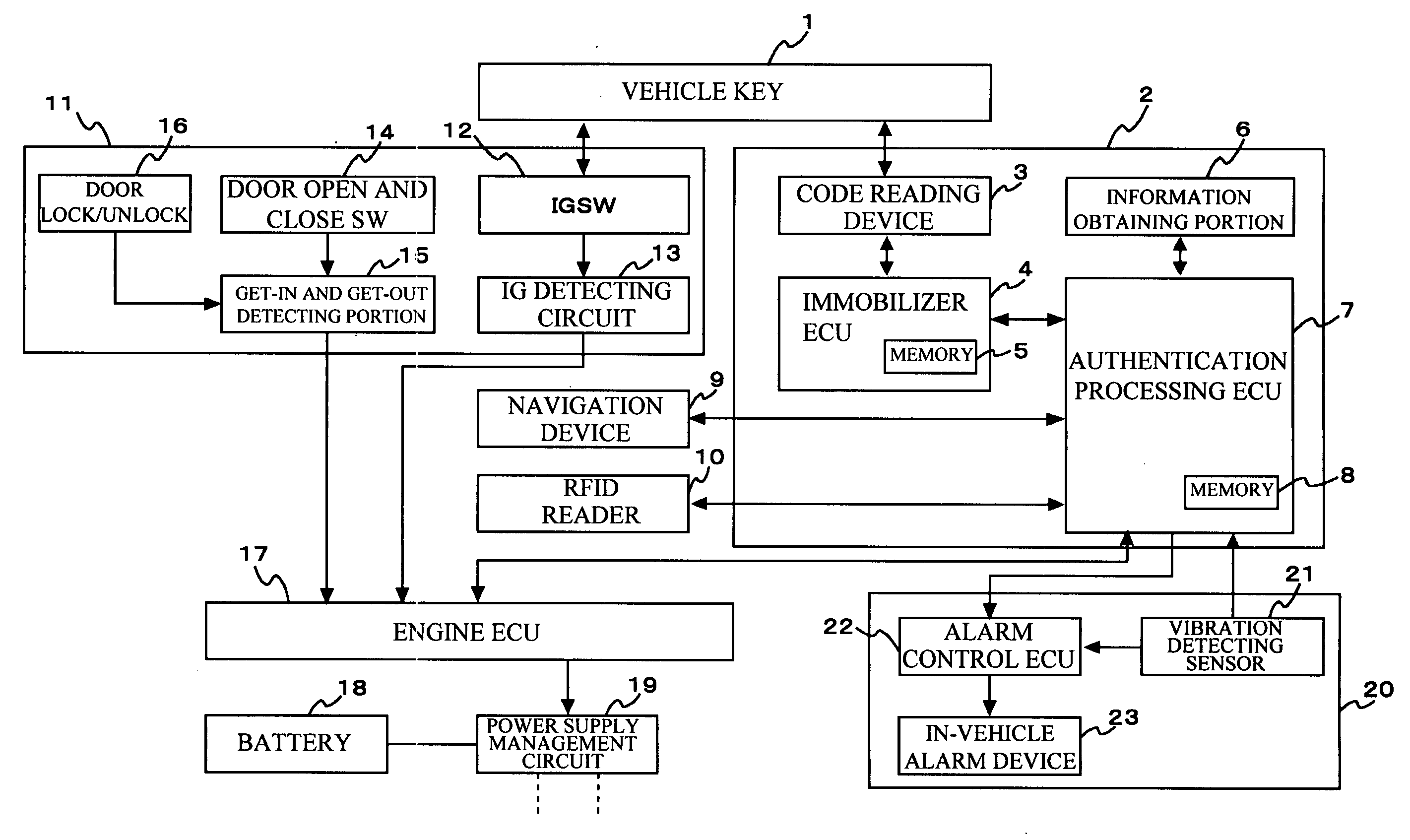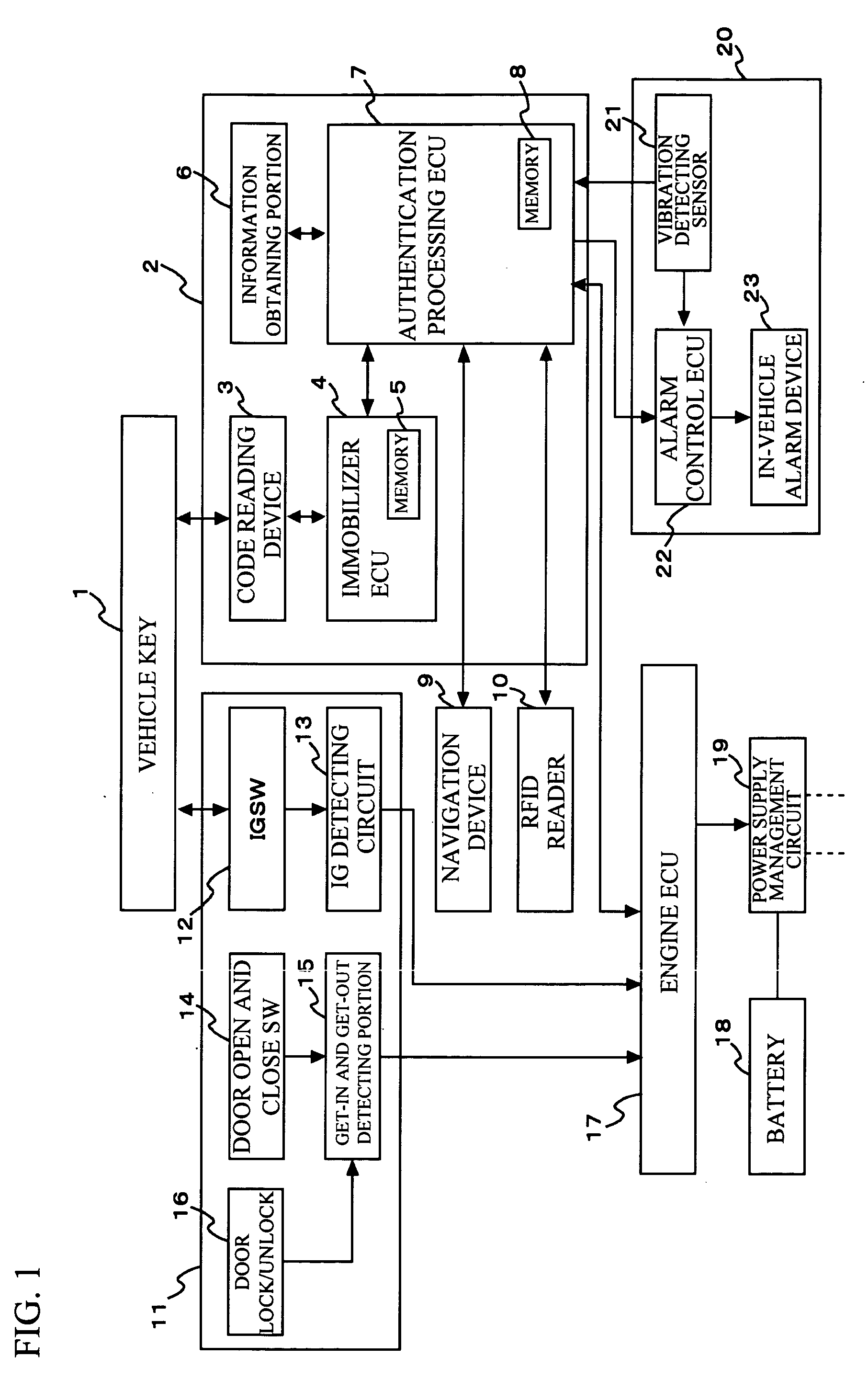Authentication apparatus and method for use in vehicle
a technology for authenticating apparatus and vehicles, applied in the field of authenticating techniques, can solve the problems of low authentication rate, low authentication speed, easy theft of vehicles, etc., and achieve the effect of shortening the time for authentication, reducing risk, and reducing the risk level
- Summary
- Abstract
- Description
- Claims
- Application Information
AI Technical Summary
Benefits of technology
Problems solved by technology
Method used
Image
Examples
first exemplary embodiment
[0025] Referring now to FIG. 1, a description will be given of a configuration of an authentication apparatus for use in vehicle in accordance with a first exemplary embodiment of the present invention. The authentication apparatus for use in vehicle employed in the first exemplary embodiment of the present invention includes: a vehicle key 1; an authentication device 2; a navigation device 9 serving as an unauthorized use risk level detecting portion; an RFID reader 10 also serving as the unauthorized use risk level detecting portion; get-in and get-out detecting portion 11 also serving as the unauthorized use risk level detecting portion; an engine ECU 17; a battery 18; a power supply management circuit 19; and an alarm device 20.
[0026] The authentication device 2 is provided with a code reading device 3; an immobilizer ECU 4 serving as the unauthorized use risk level detecting portion and also serving as an identifying portion; a biometric authentication information obtaining po...
second exemplary embodiment
[0045] A second exemplary embodiment of the present invention will be described with reference to accompanying drawings. In the present exemplary embodiment, the information of the authentication performed by the authentication processing ECU 7 such as the day of the week or the time of the day is stored in the memory 8 as a log, the day of the week or the time of the day of a high get-in frequency is determined by the authentication processing ECU 7, and the authentication level is automatically changed. In the second and later exemplary embodiments of the present invention, the same components and configurations as those employed in the first exemplary embodiment have the same reference numerals and a detailed explanation will be omitted.
[0046] A description will be given, with reference to FIG. 5, of the procedure employed in the present exemplary embodiment. The authentication processing ECU 7 implements the following processes, every time the authentication is performed. The i...
third exemplary embodiment
[0047] A third exemplary embodiment of the present invention will be described with reference to accompanying drawings. In the present exemplary embodiment, after the alarm device is operated, the authentication level is heightened to enhance the security. FIG. 6 is a flowchart of the procedure in accordance with the third exemplary embodiment of the present invention. The authentication apparatus used for vehicle employed if the present exemplary embodiment starts the following processing when an in-vehicle alarm device is operated. The in-vehicle alarm device is operated, for example, when the vibration detecting sensor 21 detects that the parked vehicle is vibrated. The parked vehicle is vibrated and the vibration detecting sensor 21 detects the vibration. When the in-vehicle alarm device 23 outputs an alarming sound by means of the control of the alarm control ECU 22, the following processes start. If the alarm is not cancelled by the operation of the vehicle key 1 or the like w...
PUM
 Login to View More
Login to View More Abstract
Description
Claims
Application Information
 Login to View More
Login to View More - R&D
- Intellectual Property
- Life Sciences
- Materials
- Tech Scout
- Unparalleled Data Quality
- Higher Quality Content
- 60% Fewer Hallucinations
Browse by: Latest US Patents, China's latest patents, Technical Efficacy Thesaurus, Application Domain, Technology Topic, Popular Technical Reports.
© 2025 PatSnap. All rights reserved.Legal|Privacy policy|Modern Slavery Act Transparency Statement|Sitemap|About US| Contact US: help@patsnap.com



